Financial Management Report on Financing and Dividend Decisions
VerifiedAdded on 2020/01/28
|11
|3950
|62
Report
AI Summary
This report delves into the crucial aspects of financial management, specifically focusing on financing and dividend decisions within a business context. It explores the impact of financing decisions, including the use of debt and equity, on a company's capital structure and shareholder wealth. The report highlights the significance of these decisions for profit maximization and the potential consequences of high debt levels. Furthermore, it examines the repercussions of the 2007-2008 global financial crisis, using Barclays Bank as a case study to illustrate the effects on debt levels, financial strategies, and dividend policies. The analysis covers the bank's responses to the crisis, including changes in debt-to-equity ratios and the strategies employed to navigate the challenging economic environment. This report provides a comprehensive overview of financial management principles and their practical application within a real-world scenario.
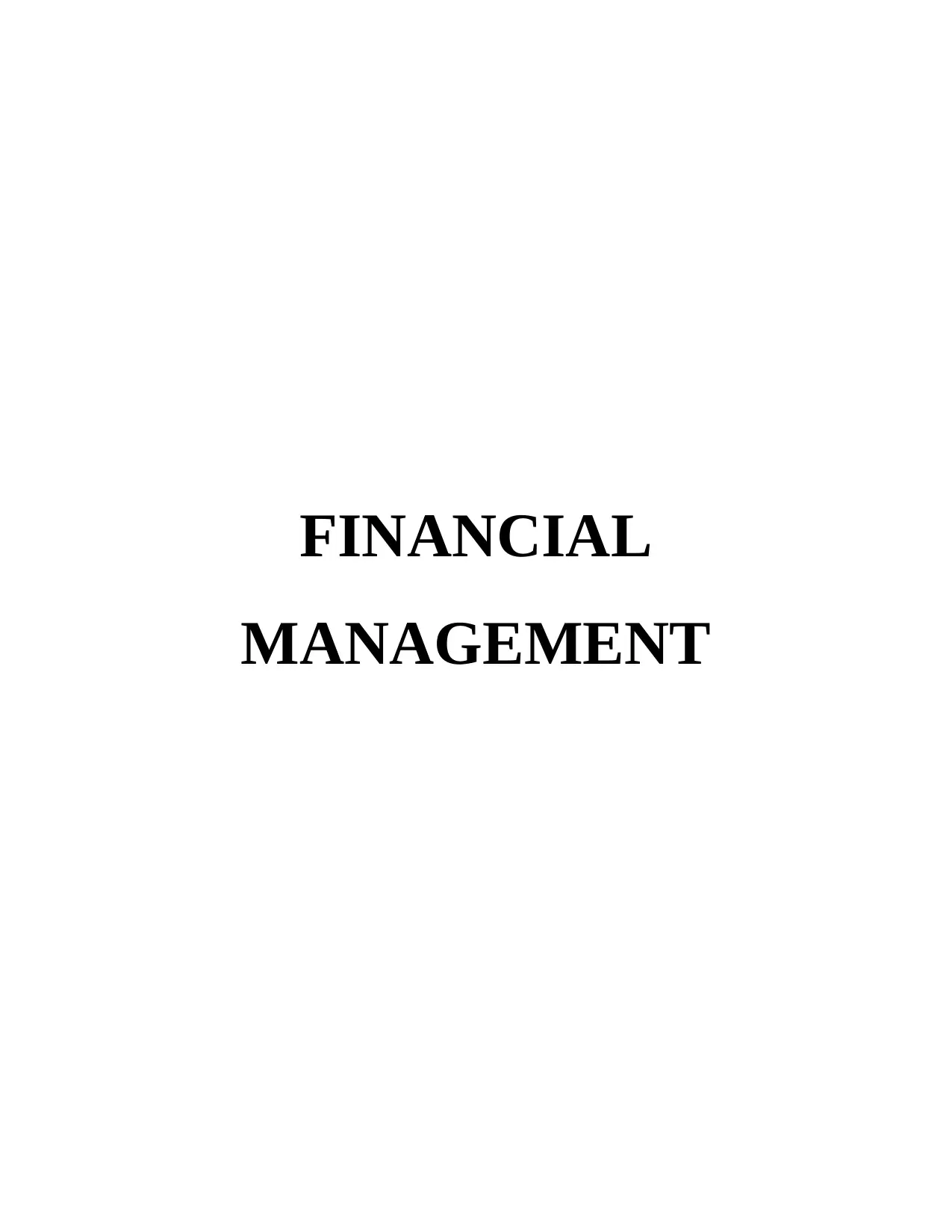
FINANCIAL
MANAGEMENT
MANAGEMENT
Paraphrase This Document
Need a fresh take? Get an instant paraphrase of this document with our AI Paraphraser
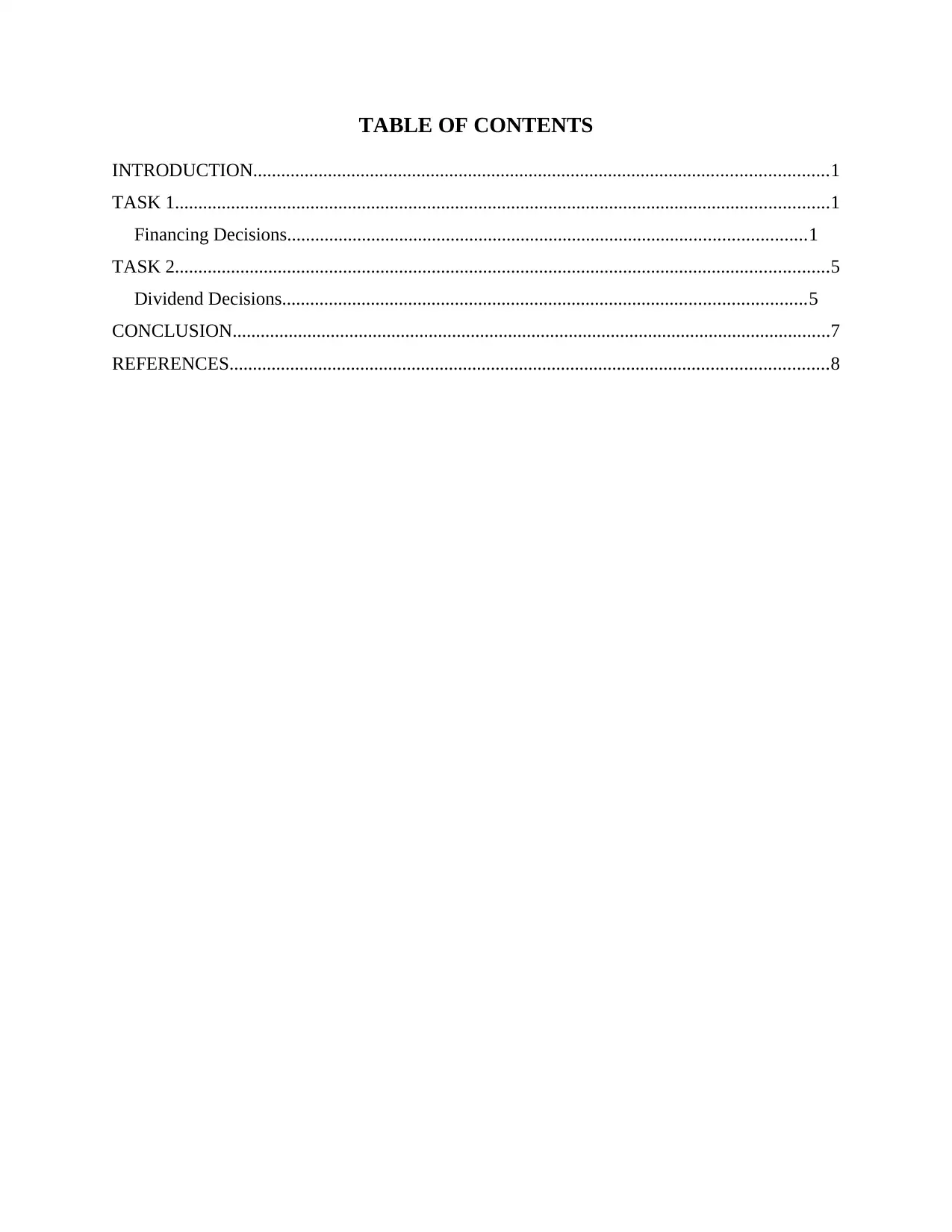
TABLE OF CONTENTS
INTRODUCTION...........................................................................................................................1
TASK 1............................................................................................................................................1
Financing Decisions...............................................................................................................1
TASK 2............................................................................................................................................5
Dividend Decisions................................................................................................................5
CONCLUSION................................................................................................................................7
REFERENCES................................................................................................................................8
INTRODUCTION...........................................................................................................................1
TASK 1............................................................................................................................................1
Financing Decisions...............................................................................................................1
TASK 2............................................................................................................................................5
Dividend Decisions................................................................................................................5
CONCLUSION................................................................................................................................7
REFERENCES................................................................................................................................8
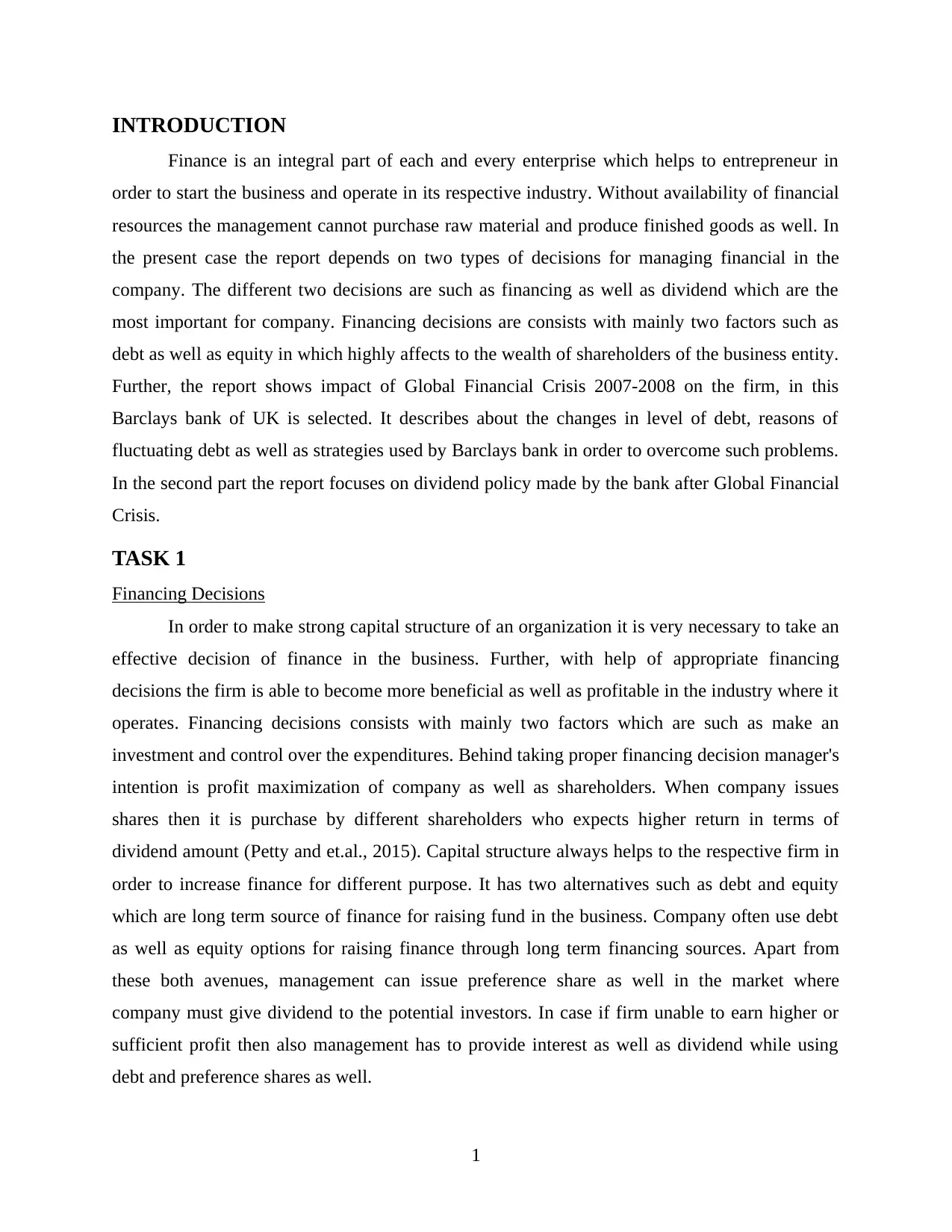
INTRODUCTION
Finance is an integral part of each and every enterprise which helps to entrepreneur in
order to start the business and operate in its respective industry. Without availability of financial
resources the management cannot purchase raw material and produce finished goods as well. In
the present case the report depends on two types of decisions for managing financial in the
company. The different two decisions are such as financing as well as dividend which are the
most important for company. Financing decisions are consists with mainly two factors such as
debt as well as equity in which highly affects to the wealth of shareholders of the business entity.
Further, the report shows impact of Global Financial Crisis 2007-2008 on the firm, in this
Barclays bank of UK is selected. It describes about the changes in level of debt, reasons of
fluctuating debt as well as strategies used by Barclays bank in order to overcome such problems.
In the second part the report focuses on dividend policy made by the bank after Global Financial
Crisis.
TASK 1
Financing Decisions
In order to make strong capital structure of an organization it is very necessary to take an
effective decision of finance in the business. Further, with help of appropriate financing
decisions the firm is able to become more beneficial as well as profitable in the industry where it
operates. Financing decisions consists with mainly two factors which are such as make an
investment and control over the expenditures. Behind taking proper financing decision manager's
intention is profit maximization of company as well as shareholders. When company issues
shares then it is purchase by different shareholders who expects higher return in terms of
dividend amount (Petty and et.al., 2015). Capital structure always helps to the respective firm in
order to increase finance for different purpose. It has two alternatives such as debt and equity
which are long term source of finance for raising fund in the business. Company often use debt
as well as equity options for raising finance through long term financing sources. Apart from
these both avenues, management can issue preference share as well in the market where
company must give dividend to the potential investors. In case if firm unable to earn higher or
sufficient profit then also management has to provide interest as well as dividend while using
debt and preference shares as well.
1
Finance is an integral part of each and every enterprise which helps to entrepreneur in
order to start the business and operate in its respective industry. Without availability of financial
resources the management cannot purchase raw material and produce finished goods as well. In
the present case the report depends on two types of decisions for managing financial in the
company. The different two decisions are such as financing as well as dividend which are the
most important for company. Financing decisions are consists with mainly two factors such as
debt as well as equity in which highly affects to the wealth of shareholders of the business entity.
Further, the report shows impact of Global Financial Crisis 2007-2008 on the firm, in this
Barclays bank of UK is selected. It describes about the changes in level of debt, reasons of
fluctuating debt as well as strategies used by Barclays bank in order to overcome such problems.
In the second part the report focuses on dividend policy made by the bank after Global Financial
Crisis.
TASK 1
Financing Decisions
In order to make strong capital structure of an organization it is very necessary to take an
effective decision of finance in the business. Further, with help of appropriate financing
decisions the firm is able to become more beneficial as well as profitable in the industry where it
operates. Financing decisions consists with mainly two factors which are such as make an
investment and control over the expenditures. Behind taking proper financing decision manager's
intention is profit maximization of company as well as shareholders. When company issues
shares then it is purchase by different shareholders who expects higher return in terms of
dividend amount (Petty and et.al., 2015). Capital structure always helps to the respective firm in
order to increase finance for different purpose. It has two alternatives such as debt and equity
which are long term source of finance for raising fund in the business. Company often use debt
as well as equity options for raising finance through long term financing sources. Apart from
these both avenues, management can issue preference share as well in the market where
company must give dividend to the potential investors. In case if firm unable to earn higher or
sufficient profit then also management has to provide interest as well as dividend while using
debt and preference shares as well.
1
⊘ This is a preview!⊘
Do you want full access?
Subscribe today to unlock all pages.

Trusted by 1+ million students worldwide
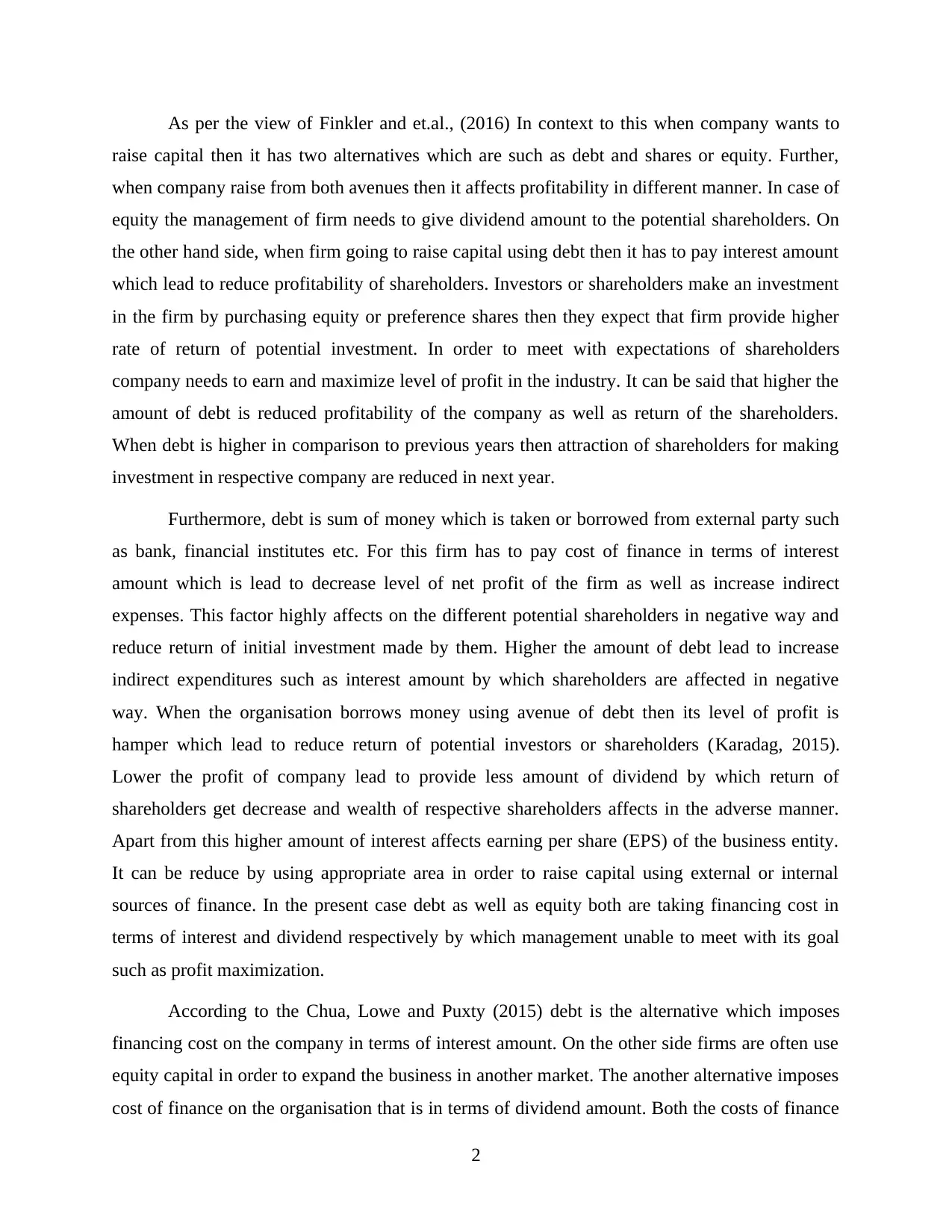
As per the view of Finkler and et.al., (2016) In context to this when company wants to
raise capital then it has two alternatives which are such as debt and shares or equity. Further,
when company raise from both avenues then it affects profitability in different manner. In case of
equity the management of firm needs to give dividend amount to the potential shareholders. On
the other hand side, when firm going to raise capital using debt then it has to pay interest amount
which lead to reduce profitability of shareholders. Investors or shareholders make an investment
in the firm by purchasing equity or preference shares then they expect that firm provide higher
rate of return of potential investment. In order to meet with expectations of shareholders
company needs to earn and maximize level of profit in the industry. It can be said that higher the
amount of debt is reduced profitability of the company as well as return of the shareholders.
When debt is higher in comparison to previous years then attraction of shareholders for making
investment in respective company are reduced in next year.
Furthermore, debt is sum of money which is taken or borrowed from external party such
as bank, financial institutes etc. For this firm has to pay cost of finance in terms of interest
amount which is lead to decrease level of net profit of the firm as well as increase indirect
expenses. This factor highly affects on the different potential shareholders in negative way and
reduce return of initial investment made by them. Higher the amount of debt lead to increase
indirect expenditures such as interest amount by which shareholders are affected in negative
way. When the organisation borrows money using avenue of debt then its level of profit is
hamper which lead to reduce return of potential investors or shareholders (Karadag, 2015).
Lower the profit of company lead to provide less amount of dividend by which return of
shareholders get decrease and wealth of respective shareholders affects in the adverse manner.
Apart from this higher amount of interest affects earning per share (EPS) of the business entity.
It can be reduce by using appropriate area in order to raise capital using external or internal
sources of finance. In the present case debt as well as equity both are taking financing cost in
terms of interest and dividend respectively by which management unable to meet with its goal
such as profit maximization.
According to the Chua, Lowe and Puxty (2015) debt is the alternative which imposes
financing cost on the company in terms of interest amount. On the other side firms are often use
equity capital in order to expand the business in another market. The another alternative imposes
cost of finance on the organisation that is in terms of dividend amount. Both the costs of finance
2
raise capital then it has two alternatives which are such as debt and shares or equity. Further,
when company raise from both avenues then it affects profitability in different manner. In case of
equity the management of firm needs to give dividend amount to the potential shareholders. On
the other hand side, when firm going to raise capital using debt then it has to pay interest amount
which lead to reduce profitability of shareholders. Investors or shareholders make an investment
in the firm by purchasing equity or preference shares then they expect that firm provide higher
rate of return of potential investment. In order to meet with expectations of shareholders
company needs to earn and maximize level of profit in the industry. It can be said that higher the
amount of debt is reduced profitability of the company as well as return of the shareholders.
When debt is higher in comparison to previous years then attraction of shareholders for making
investment in respective company are reduced in next year.
Furthermore, debt is sum of money which is taken or borrowed from external party such
as bank, financial institutes etc. For this firm has to pay cost of finance in terms of interest
amount which is lead to decrease level of net profit of the firm as well as increase indirect
expenses. This factor highly affects on the different potential shareholders in negative way and
reduce return of initial investment made by them. Higher the amount of debt lead to increase
indirect expenditures such as interest amount by which shareholders are affected in negative
way. When the organisation borrows money using avenue of debt then its level of profit is
hamper which lead to reduce return of potential investors or shareholders (Karadag, 2015).
Lower the profit of company lead to provide less amount of dividend by which return of
shareholders get decrease and wealth of respective shareholders affects in the adverse manner.
Apart from this higher amount of interest affects earning per share (EPS) of the business entity.
It can be reduce by using appropriate area in order to raise capital using external or internal
sources of finance. In the present case debt as well as equity both are taking financing cost in
terms of interest and dividend respectively by which management unable to meet with its goal
such as profit maximization.
According to the Chua, Lowe and Puxty (2015) debt is the alternative which imposes
financing cost on the company in terms of interest amount. On the other side firms are often use
equity capital in order to expand the business in another market. The another alternative imposes
cost of finance on the organisation that is in terms of dividend amount. Both the costs of finance
2
Paraphrase This Document
Need a fresh take? Get an instant paraphrase of this document with our AI Paraphraser
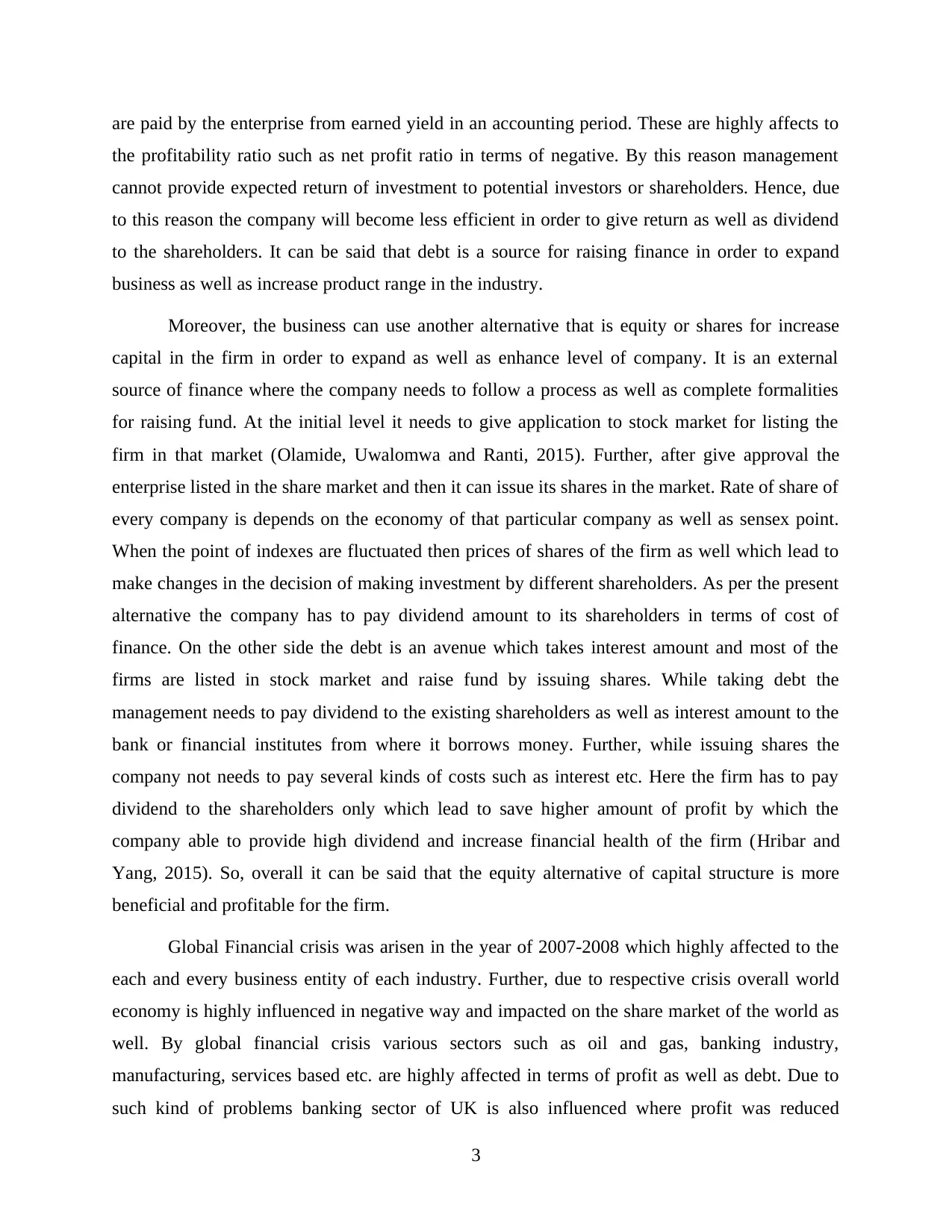
are paid by the enterprise from earned yield in an accounting period. These are highly affects to
the profitability ratio such as net profit ratio in terms of negative. By this reason management
cannot provide expected return of investment to potential investors or shareholders. Hence, due
to this reason the company will become less efficient in order to give return as well as dividend
to the shareholders. It can be said that debt is a source for raising finance in order to expand
business as well as increase product range in the industry.
Moreover, the business can use another alternative that is equity or shares for increase
capital in the firm in order to expand as well as enhance level of company. It is an external
source of finance where the company needs to follow a process as well as complete formalities
for raising fund. At the initial level it needs to give application to stock market for listing the
firm in that market (Olamide, Uwalomwa and Ranti, 2015). Further, after give approval the
enterprise listed in the share market and then it can issue its shares in the market. Rate of share of
every company is depends on the economy of that particular company as well as sensex point.
When the point of indexes are fluctuated then prices of shares of the firm as well which lead to
make changes in the decision of making investment by different shareholders. As per the present
alternative the company has to pay dividend amount to its shareholders in terms of cost of
finance. On the other side the debt is an avenue which takes interest amount and most of the
firms are listed in stock market and raise fund by issuing shares. While taking debt the
management needs to pay dividend to the existing shareholders as well as interest amount to the
bank or financial institutes from where it borrows money. Further, while issuing shares the
company not needs to pay several kinds of costs such as interest etc. Here the firm has to pay
dividend to the shareholders only which lead to save higher amount of profit by which the
company able to provide high dividend and increase financial health of the firm (Hribar and
Yang, 2015). So, overall it can be said that the equity alternative of capital structure is more
beneficial and profitable for the firm.
Global Financial crisis was arisen in the year of 2007-2008 which highly affected to the
each and every business entity of each industry. Further, due to respective crisis overall world
economy is highly influenced in negative way and impacted on the share market of the world as
well. By global financial crisis various sectors such as oil and gas, banking industry,
manufacturing, services based etc. are highly affected in terms of profit as well as debt. Due to
such kind of problems banking sector of UK is also influenced where profit was reduced
3
the profitability ratio such as net profit ratio in terms of negative. By this reason management
cannot provide expected return of investment to potential investors or shareholders. Hence, due
to this reason the company will become less efficient in order to give return as well as dividend
to the shareholders. It can be said that debt is a source for raising finance in order to expand
business as well as increase product range in the industry.
Moreover, the business can use another alternative that is equity or shares for increase
capital in the firm in order to expand as well as enhance level of company. It is an external
source of finance where the company needs to follow a process as well as complete formalities
for raising fund. At the initial level it needs to give application to stock market for listing the
firm in that market (Olamide, Uwalomwa and Ranti, 2015). Further, after give approval the
enterprise listed in the share market and then it can issue its shares in the market. Rate of share of
every company is depends on the economy of that particular company as well as sensex point.
When the point of indexes are fluctuated then prices of shares of the firm as well which lead to
make changes in the decision of making investment by different shareholders. As per the present
alternative the company has to pay dividend amount to its shareholders in terms of cost of
finance. On the other side the debt is an avenue which takes interest amount and most of the
firms are listed in stock market and raise fund by issuing shares. While taking debt the
management needs to pay dividend to the existing shareholders as well as interest amount to the
bank or financial institutes from where it borrows money. Further, while issuing shares the
company not needs to pay several kinds of costs such as interest etc. Here the firm has to pay
dividend to the shareholders only which lead to save higher amount of profit by which the
company able to provide high dividend and increase financial health of the firm (Hribar and
Yang, 2015). So, overall it can be said that the equity alternative of capital structure is more
beneficial and profitable for the firm.
Global Financial crisis was arisen in the year of 2007-2008 which highly affected to the
each and every business entity of each industry. Further, due to respective crisis overall world
economy is highly influenced in negative way and impacted on the share market of the world as
well. By global financial crisis various sectors such as oil and gas, banking industry,
manufacturing, services based etc. are highly affected in terms of profit as well as debt. Due to
such kind of problems banking sector of UK is also influenced where profit was reduced
3
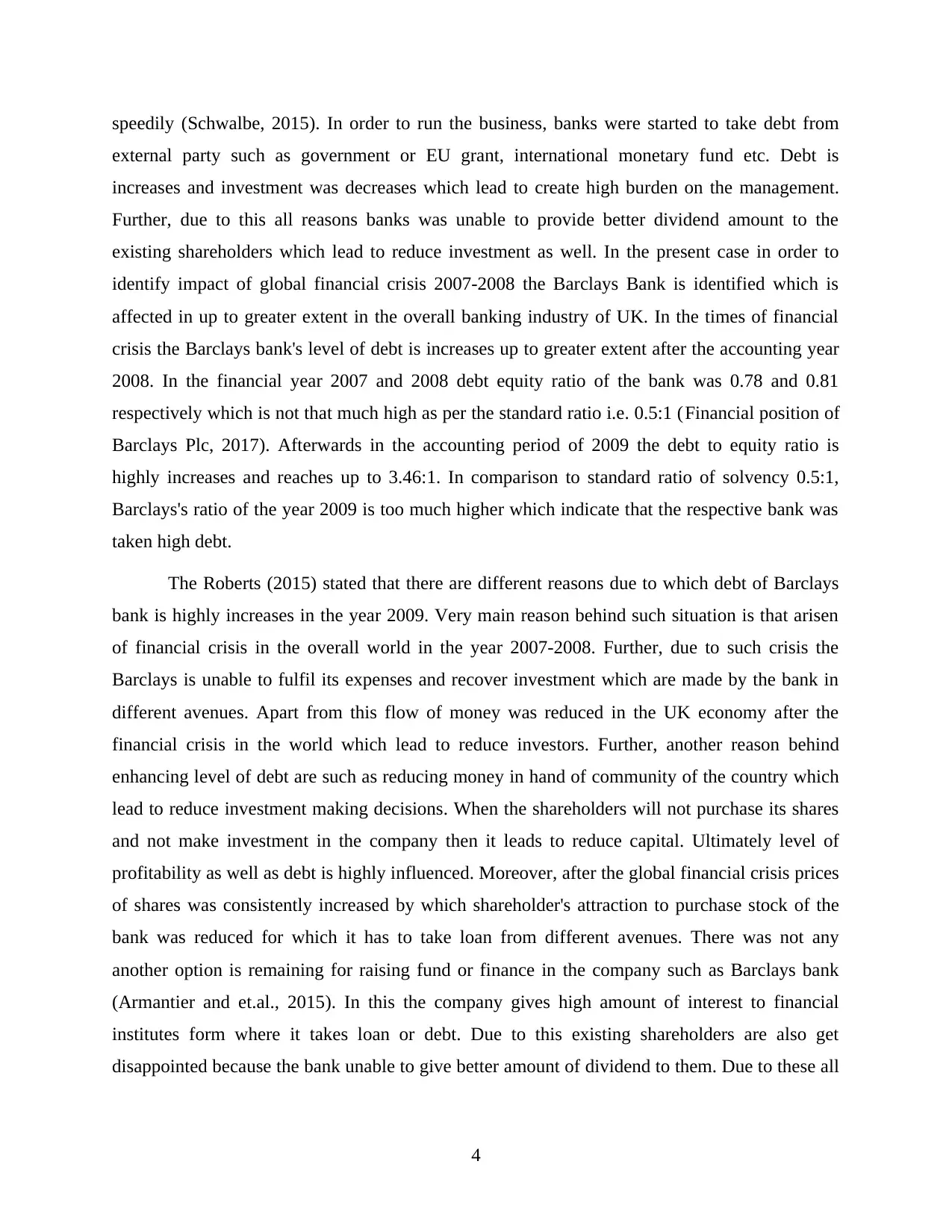
speedily (Schwalbe, 2015). In order to run the business, banks were started to take debt from
external party such as government or EU grant, international monetary fund etc. Debt is
increases and investment was decreases which lead to create high burden on the management.
Further, due to this all reasons banks was unable to provide better dividend amount to the
existing shareholders which lead to reduce investment as well. In the present case in order to
identify impact of global financial crisis 2007-2008 the Barclays Bank is identified which is
affected in up to greater extent in the overall banking industry of UK. In the times of financial
crisis the Barclays bank's level of debt is increases up to greater extent after the accounting year
2008. In the financial year 2007 and 2008 debt equity ratio of the bank was 0.78 and 0.81
respectively which is not that much high as per the standard ratio i.e. 0.5:1 (Financial position of
Barclays Plc, 2017). Afterwards in the accounting period of 2009 the debt to equity ratio is
highly increases and reaches up to 3.46:1. In comparison to standard ratio of solvency 0.5:1,
Barclays's ratio of the year 2009 is too much higher which indicate that the respective bank was
taken high debt.
The Roberts (2015) stated that there are different reasons due to which debt of Barclays
bank is highly increases in the year 2009. Very main reason behind such situation is that arisen
of financial crisis in the overall world in the year 2007-2008. Further, due to such crisis the
Barclays is unable to fulfil its expenses and recover investment which are made by the bank in
different avenues. Apart from this flow of money was reduced in the UK economy after the
financial crisis in the world which lead to reduce investors. Further, another reason behind
enhancing level of debt are such as reducing money in hand of community of the country which
lead to reduce investment making decisions. When the shareholders will not purchase its shares
and not make investment in the company then it leads to reduce capital. Ultimately level of
profitability as well as debt is highly influenced. Moreover, after the global financial crisis prices
of shares was consistently increased by which shareholder's attraction to purchase stock of the
bank was reduced for which it has to take loan from different avenues. There was not any
another option is remaining for raising fund or finance in the company such as Barclays bank
(Armantier and et.al., 2015). In this the company gives high amount of interest to financial
institutes form where it takes loan or debt. Due to this existing shareholders are also get
disappointed because the bank unable to give better amount of dividend to them. Due to these all
4
external party such as government or EU grant, international monetary fund etc. Debt is
increases and investment was decreases which lead to create high burden on the management.
Further, due to this all reasons banks was unable to provide better dividend amount to the
existing shareholders which lead to reduce investment as well. In the present case in order to
identify impact of global financial crisis 2007-2008 the Barclays Bank is identified which is
affected in up to greater extent in the overall banking industry of UK. In the times of financial
crisis the Barclays bank's level of debt is increases up to greater extent after the accounting year
2008. In the financial year 2007 and 2008 debt equity ratio of the bank was 0.78 and 0.81
respectively which is not that much high as per the standard ratio i.e. 0.5:1 (Financial position of
Barclays Plc, 2017). Afterwards in the accounting period of 2009 the debt to equity ratio is
highly increases and reaches up to 3.46:1. In comparison to standard ratio of solvency 0.5:1,
Barclays's ratio of the year 2009 is too much higher which indicate that the respective bank was
taken high debt.
The Roberts (2015) stated that there are different reasons due to which debt of Barclays
bank is highly increases in the year 2009. Very main reason behind such situation is that arisen
of financial crisis in the overall world in the year 2007-2008. Further, due to such crisis the
Barclays is unable to fulfil its expenses and recover investment which are made by the bank in
different avenues. Apart from this flow of money was reduced in the UK economy after the
financial crisis in the world which lead to reduce investors. Further, another reason behind
enhancing level of debt are such as reducing money in hand of community of the country which
lead to reduce investment making decisions. When the shareholders will not purchase its shares
and not make investment in the company then it leads to reduce capital. Ultimately level of
profitability as well as debt is highly influenced. Moreover, after the global financial crisis prices
of shares was consistently increased by which shareholder's attraction to purchase stock of the
bank was reduced for which it has to take loan from different avenues. There was not any
another option is remaining for raising fund or finance in the company such as Barclays bank
(Armantier and et.al., 2015). In this the company gives high amount of interest to financial
institutes form where it takes loan or debt. Due to this existing shareholders are also get
disappointed because the bank unable to give better amount of dividend to them. Due to these all
4
⊘ This is a preview!⊘
Do you want full access?
Subscribe today to unlock all pages.

Trusted by 1+ million students worldwide
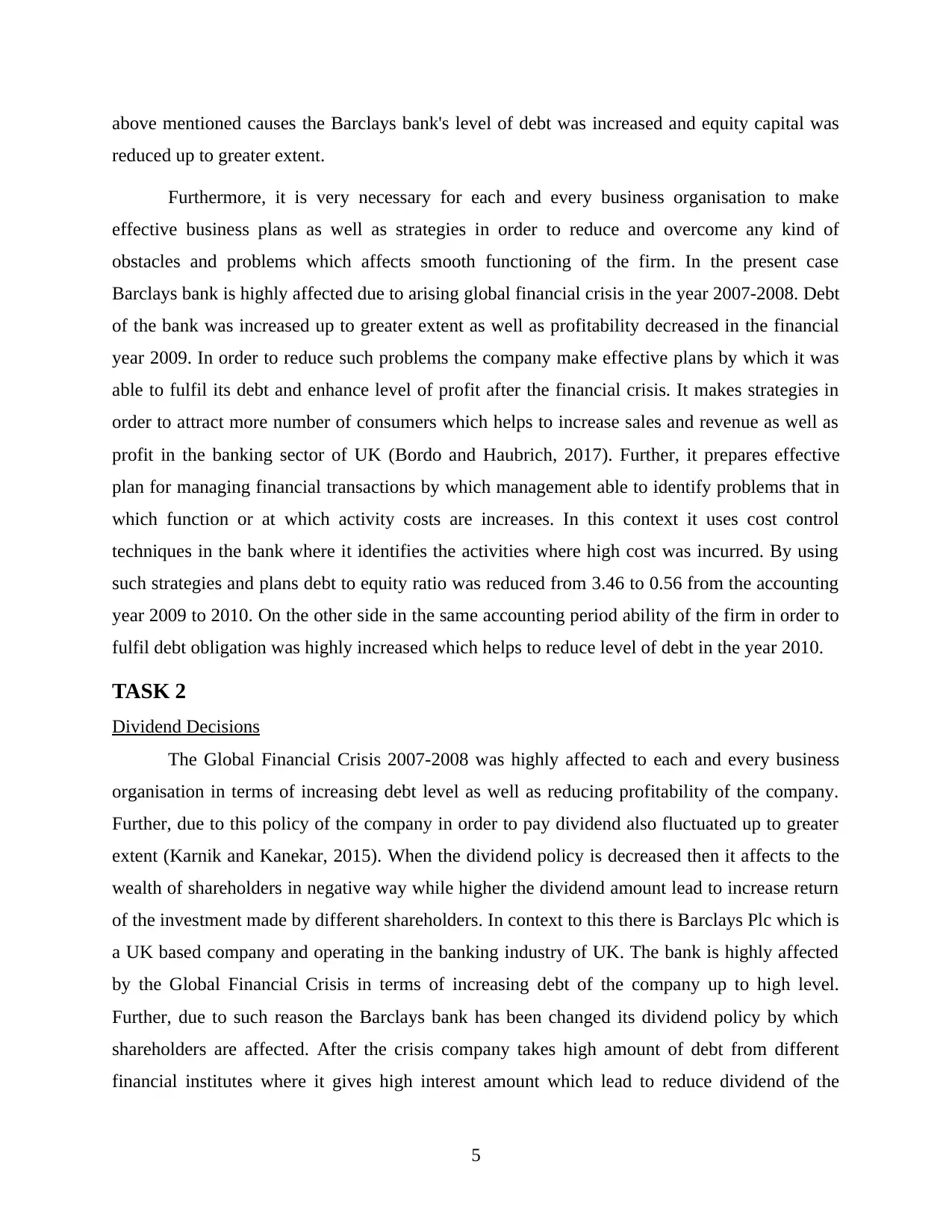
above mentioned causes the Barclays bank's level of debt was increased and equity capital was
reduced up to greater extent.
Furthermore, it is very necessary for each and every business organisation to make
effective business plans as well as strategies in order to reduce and overcome any kind of
obstacles and problems which affects smooth functioning of the firm. In the present case
Barclays bank is highly affected due to arising global financial crisis in the year 2007-2008. Debt
of the bank was increased up to greater extent as well as profitability decreased in the financial
year 2009. In order to reduce such problems the company make effective plans by which it was
able to fulfil its debt and enhance level of profit after the financial crisis. It makes strategies in
order to attract more number of consumers which helps to increase sales and revenue as well as
profit in the banking sector of UK (Bordo and Haubrich, 2017). Further, it prepares effective
plan for managing financial transactions by which management able to identify problems that in
which function or at which activity costs are increases. In this context it uses cost control
techniques in the bank where it identifies the activities where high cost was incurred. By using
such strategies and plans debt to equity ratio was reduced from 3.46 to 0.56 from the accounting
year 2009 to 2010. On the other side in the same accounting period ability of the firm in order to
fulfil debt obligation was highly increased which helps to reduce level of debt in the year 2010.
TASK 2
Dividend Decisions
The Global Financial Crisis 2007-2008 was highly affected to each and every business
organisation in terms of increasing debt level as well as reducing profitability of the company.
Further, due to this policy of the company in order to pay dividend also fluctuated up to greater
extent (Karnik and Kanekar, 2015). When the dividend policy is decreased then it affects to the
wealth of shareholders in negative way while higher the dividend amount lead to increase return
of the investment made by different shareholders. In context to this there is Barclays Plc which is
a UK based company and operating in the banking industry of UK. The bank is highly affected
by the Global Financial Crisis in terms of increasing debt of the company up to high level.
Further, due to such reason the Barclays bank has been changed its dividend policy by which
shareholders are affected. After the crisis company takes high amount of debt from different
financial institutes where it gives high interest amount which lead to reduce dividend of the
5
reduced up to greater extent.
Furthermore, it is very necessary for each and every business organisation to make
effective business plans as well as strategies in order to reduce and overcome any kind of
obstacles and problems which affects smooth functioning of the firm. In the present case
Barclays bank is highly affected due to arising global financial crisis in the year 2007-2008. Debt
of the bank was increased up to greater extent as well as profitability decreased in the financial
year 2009. In order to reduce such problems the company make effective plans by which it was
able to fulfil its debt and enhance level of profit after the financial crisis. It makes strategies in
order to attract more number of consumers which helps to increase sales and revenue as well as
profit in the banking sector of UK (Bordo and Haubrich, 2017). Further, it prepares effective
plan for managing financial transactions by which management able to identify problems that in
which function or at which activity costs are increases. In this context it uses cost control
techniques in the bank where it identifies the activities where high cost was incurred. By using
such strategies and plans debt to equity ratio was reduced from 3.46 to 0.56 from the accounting
year 2009 to 2010. On the other side in the same accounting period ability of the firm in order to
fulfil debt obligation was highly increased which helps to reduce level of debt in the year 2010.
TASK 2
Dividend Decisions
The Global Financial Crisis 2007-2008 was highly affected to each and every business
organisation in terms of increasing debt level as well as reducing profitability of the company.
Further, due to this policy of the company in order to pay dividend also fluctuated up to greater
extent (Karnik and Kanekar, 2015). When the dividend policy is decreased then it affects to the
wealth of shareholders in negative way while higher the dividend amount lead to increase return
of the investment made by different shareholders. In context to this there is Barclays Plc which is
a UK based company and operating in the banking industry of UK. The bank is highly affected
by the Global Financial Crisis in terms of increasing debt of the company up to high level.
Further, due to such reason the Barclays bank has been changed its dividend policy by which
shareholders are affected. After the crisis company takes high amount of debt from different
financial institutes where it gives high interest amount which lead to reduce dividend of the
5
Paraphrase This Document
Need a fresh take? Get an instant paraphrase of this document with our AI Paraphraser
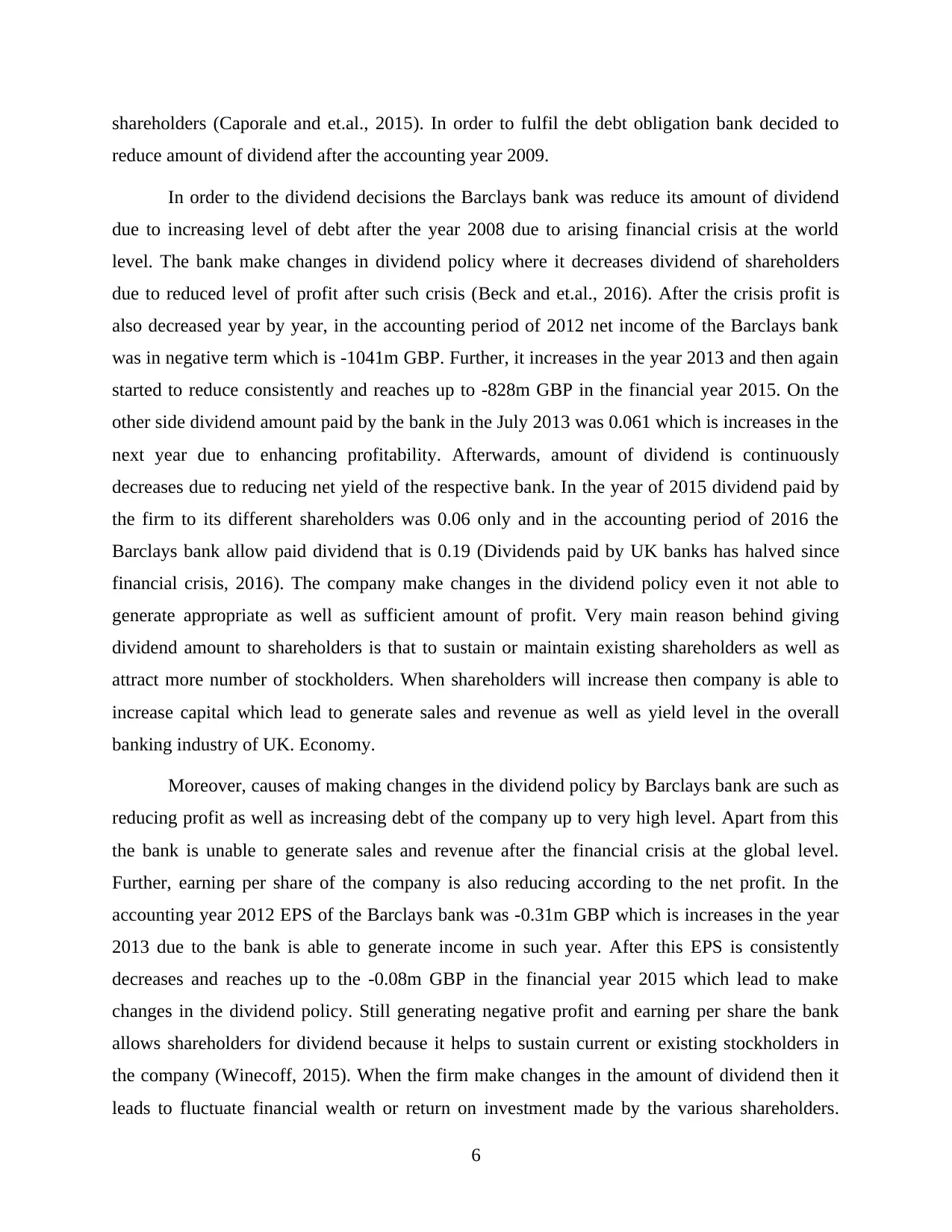
shareholders (Caporale and et.al., 2015). In order to fulfil the debt obligation bank decided to
reduce amount of dividend after the accounting year 2009.
In order to the dividend decisions the Barclays bank was reduce its amount of dividend
due to increasing level of debt after the year 2008 due to arising financial crisis at the world
level. The bank make changes in dividend policy where it decreases dividend of shareholders
due to reduced level of profit after such crisis (Beck and et.al., 2016). After the crisis profit is
also decreased year by year, in the accounting period of 2012 net income of the Barclays bank
was in negative term which is -1041m GBP. Further, it increases in the year 2013 and then again
started to reduce consistently and reaches up to -828m GBP in the financial year 2015. On the
other side dividend amount paid by the bank in the July 2013 was 0.061 which is increases in the
next year due to enhancing profitability. Afterwards, amount of dividend is continuously
decreases due to reducing net yield of the respective bank. In the year of 2015 dividend paid by
the firm to its different shareholders was 0.06 only and in the accounting period of 2016 the
Barclays bank allow paid dividend that is 0.19 (Dividends paid by UK banks has halved since
financial crisis, 2016). The company make changes in the dividend policy even it not able to
generate appropriate as well as sufficient amount of profit. Very main reason behind giving
dividend amount to shareholders is that to sustain or maintain existing shareholders as well as
attract more number of stockholders. When shareholders will increase then company is able to
increase capital which lead to generate sales and revenue as well as yield level in the overall
banking industry of UK. Economy.
Moreover, causes of making changes in the dividend policy by Barclays bank are such as
reducing profit as well as increasing debt of the company up to very high level. Apart from this
the bank is unable to generate sales and revenue after the financial crisis at the global level.
Further, earning per share of the company is also reducing according to the net profit. In the
accounting year 2012 EPS of the Barclays bank was -0.31m GBP which is increases in the year
2013 due to the bank is able to generate income in such year. After this EPS is consistently
decreases and reaches up to the -0.08m GBP in the financial year 2015 which lead to make
changes in the dividend policy. Still generating negative profit and earning per share the bank
allows shareholders for dividend because it helps to sustain current or existing stockholders in
the company (Winecoff, 2015). When the firm make changes in the amount of dividend then it
leads to fluctuate financial wealth or return on investment made by the various shareholders.
6
reduce amount of dividend after the accounting year 2009.
In order to the dividend decisions the Barclays bank was reduce its amount of dividend
due to increasing level of debt after the year 2008 due to arising financial crisis at the world
level. The bank make changes in dividend policy where it decreases dividend of shareholders
due to reduced level of profit after such crisis (Beck and et.al., 2016). After the crisis profit is
also decreased year by year, in the accounting period of 2012 net income of the Barclays bank
was in negative term which is -1041m GBP. Further, it increases in the year 2013 and then again
started to reduce consistently and reaches up to -828m GBP in the financial year 2015. On the
other side dividend amount paid by the bank in the July 2013 was 0.061 which is increases in the
next year due to enhancing profitability. Afterwards, amount of dividend is continuously
decreases due to reducing net yield of the respective bank. In the year of 2015 dividend paid by
the firm to its different shareholders was 0.06 only and in the accounting period of 2016 the
Barclays bank allow paid dividend that is 0.19 (Dividends paid by UK banks has halved since
financial crisis, 2016). The company make changes in the dividend policy even it not able to
generate appropriate as well as sufficient amount of profit. Very main reason behind giving
dividend amount to shareholders is that to sustain or maintain existing shareholders as well as
attract more number of stockholders. When shareholders will increase then company is able to
increase capital which lead to generate sales and revenue as well as yield level in the overall
banking industry of UK. Economy.
Moreover, causes of making changes in the dividend policy by Barclays bank are such as
reducing profit as well as increasing debt of the company up to very high level. Apart from this
the bank is unable to generate sales and revenue after the financial crisis at the global level.
Further, earning per share of the company is also reducing according to the net profit. In the
accounting year 2012 EPS of the Barclays bank was -0.31m GBP which is increases in the year
2013 due to the bank is able to generate income in such year. After this EPS is consistently
decreases and reaches up to the -0.08m GBP in the financial year 2015 which lead to make
changes in the dividend policy. Still generating negative profit and earning per share the bank
allows shareholders for dividend because it helps to sustain current or existing stockholders in
the company (Winecoff, 2015). When the firm make changes in the amount of dividend then it
leads to fluctuate financial wealth or return on investment made by the various shareholders.
6
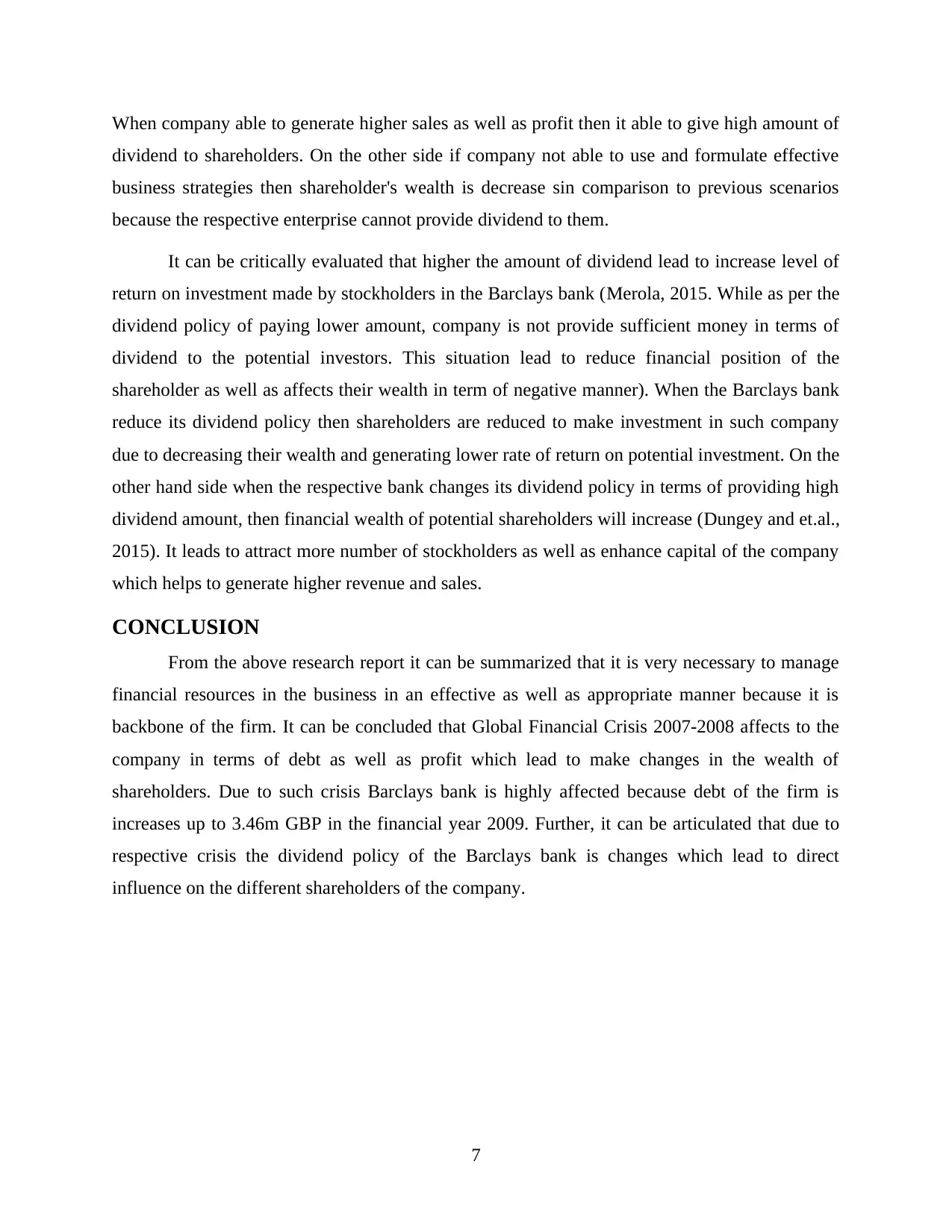
When company able to generate higher sales as well as profit then it able to give high amount of
dividend to shareholders. On the other side if company not able to use and formulate effective
business strategies then shareholder's wealth is decrease sin comparison to previous scenarios
because the respective enterprise cannot provide dividend to them.
It can be critically evaluated that higher the amount of dividend lead to increase level of
return on investment made by stockholders in the Barclays bank (Merola, 2015. While as per the
dividend policy of paying lower amount, company is not provide sufficient money in terms of
dividend to the potential investors. This situation lead to reduce financial position of the
shareholder as well as affects their wealth in term of negative manner). When the Barclays bank
reduce its dividend policy then shareholders are reduced to make investment in such company
due to decreasing their wealth and generating lower rate of return on potential investment. On the
other hand side when the respective bank changes its dividend policy in terms of providing high
dividend amount, then financial wealth of potential shareholders will increase (Dungey and et.al.,
2015). It leads to attract more number of stockholders as well as enhance capital of the company
which helps to generate higher revenue and sales.
CONCLUSION
From the above research report it can be summarized that it is very necessary to manage
financial resources in the business in an effective as well as appropriate manner because it is
backbone of the firm. It can be concluded that Global Financial Crisis 2007-2008 affects to the
company in terms of debt as well as profit which lead to make changes in the wealth of
shareholders. Due to such crisis Barclays bank is highly affected because debt of the firm is
increases up to 3.46m GBP in the financial year 2009. Further, it can be articulated that due to
respective crisis the dividend policy of the Barclays bank is changes which lead to direct
influence on the different shareholders of the company.
7
dividend to shareholders. On the other side if company not able to use and formulate effective
business strategies then shareholder's wealth is decrease sin comparison to previous scenarios
because the respective enterprise cannot provide dividend to them.
It can be critically evaluated that higher the amount of dividend lead to increase level of
return on investment made by stockholders in the Barclays bank (Merola, 2015. While as per the
dividend policy of paying lower amount, company is not provide sufficient money in terms of
dividend to the potential investors. This situation lead to reduce financial position of the
shareholder as well as affects their wealth in term of negative manner). When the Barclays bank
reduce its dividend policy then shareholders are reduced to make investment in such company
due to decreasing their wealth and generating lower rate of return on potential investment. On the
other hand side when the respective bank changes its dividend policy in terms of providing high
dividend amount, then financial wealth of potential shareholders will increase (Dungey and et.al.,
2015). It leads to attract more number of stockholders as well as enhance capital of the company
which helps to generate higher revenue and sales.
CONCLUSION
From the above research report it can be summarized that it is very necessary to manage
financial resources in the business in an effective as well as appropriate manner because it is
backbone of the firm. It can be concluded that Global Financial Crisis 2007-2008 affects to the
company in terms of debt as well as profit which lead to make changes in the wealth of
shareholders. Due to such crisis Barclays bank is highly affected because debt of the firm is
increases up to 3.46m GBP in the financial year 2009. Further, it can be articulated that due to
respective crisis the dividend policy of the Barclays bank is changes which lead to direct
influence on the different shareholders of the company.
7
⊘ This is a preview!⊘
Do you want full access?
Subscribe today to unlock all pages.

Trusted by 1+ million students worldwide
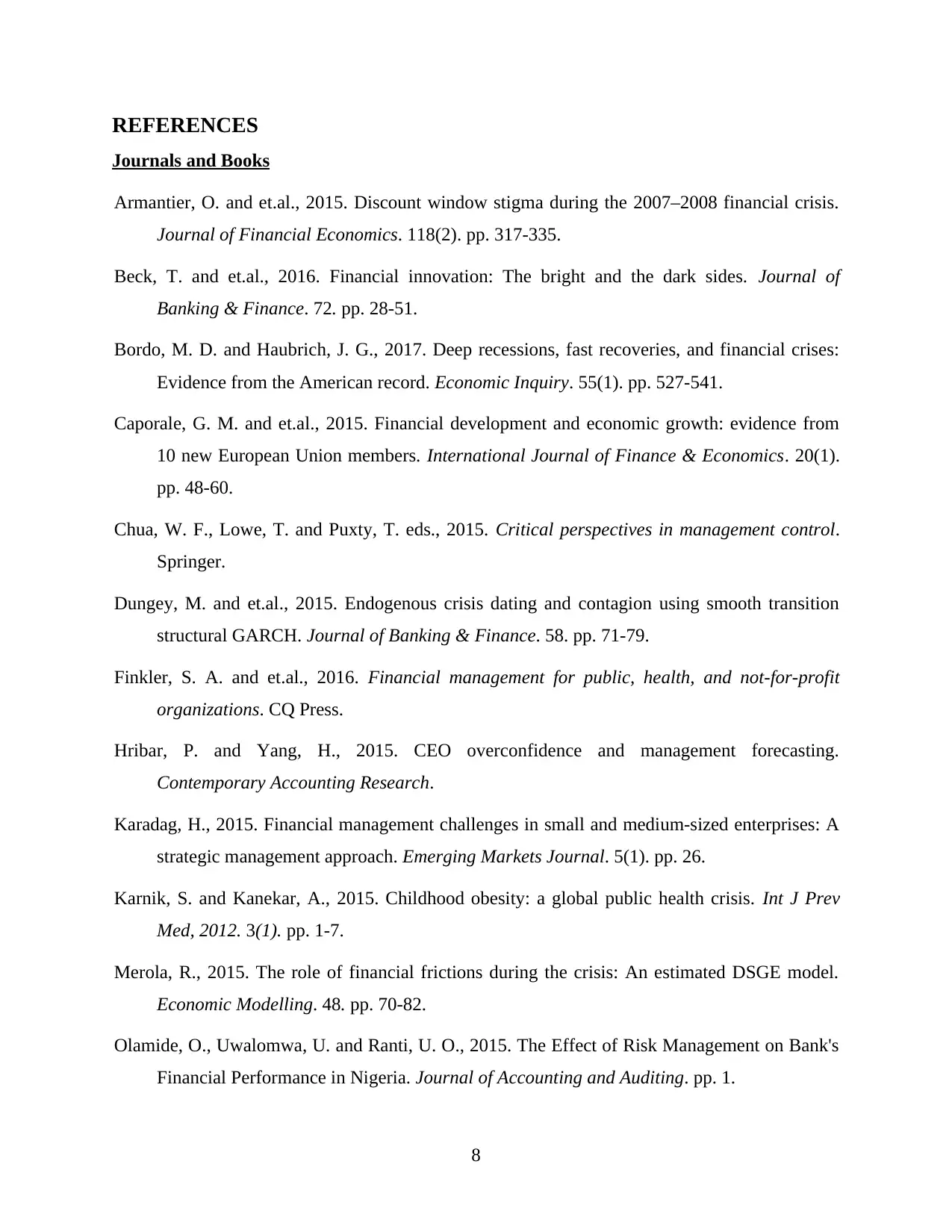
REFERENCES
Journals and Books
Armantier, O. and et.al., 2015. Discount window stigma during the 2007–2008 financial crisis.
Journal of Financial Economics. 118(2). pp. 317-335.
Beck, T. and et.al., 2016. Financial innovation: The bright and the dark sides. Journal of
Banking & Finance. 72. pp. 28-51.
Bordo, M. D. and Haubrich, J. G., 2017. Deep recessions, fast recoveries, and financial crises:
Evidence from the American record. Economic Inquiry. 55(1). pp. 527-541.
Caporale, G. M. and et.al., 2015. Financial development and economic growth: evidence from
10 new European Union members. International Journal of Finance & Economics. 20(1).
pp. 48-60.
Chua, W. F., Lowe, T. and Puxty, T. eds., 2015. Critical perspectives in management control.
Springer.
Dungey, M. and et.al., 2015. Endogenous crisis dating and contagion using smooth transition
structural GARCH. Journal of Banking & Finance. 58. pp. 71-79.
Finkler, S. A. and et.al., 2016. Financial management for public, health, and not-for-profit
organizations. CQ Press.
Hribar, P. and Yang, H., 2015. CEO overconfidence and management forecasting.
Contemporary Accounting Research.
Karadag, H., 2015. Financial management challenges in small and medium-sized enterprises: A
strategic management approach. Emerging Markets Journal. 5(1). pp. 26.
Karnik, S. and Kanekar, A., 2015. Childhood obesity: a global public health crisis. Int J Prev
Med, 2012. 3(1). pp. 1-7.
Merola, R., 2015. The role of financial frictions during the crisis: An estimated DSGE model.
Economic Modelling. 48. pp. 70-82.
Olamide, O., Uwalomwa, U. and Ranti, U. O., 2015. The Effect of Risk Management on Bank's
Financial Performance in Nigeria. Journal of Accounting and Auditing. pp. 1.
8
Journals and Books
Armantier, O. and et.al., 2015. Discount window stigma during the 2007–2008 financial crisis.
Journal of Financial Economics. 118(2). pp. 317-335.
Beck, T. and et.al., 2016. Financial innovation: The bright and the dark sides. Journal of
Banking & Finance. 72. pp. 28-51.
Bordo, M. D. and Haubrich, J. G., 2017. Deep recessions, fast recoveries, and financial crises:
Evidence from the American record. Economic Inquiry. 55(1). pp. 527-541.
Caporale, G. M. and et.al., 2015. Financial development and economic growth: evidence from
10 new European Union members. International Journal of Finance & Economics. 20(1).
pp. 48-60.
Chua, W. F., Lowe, T. and Puxty, T. eds., 2015. Critical perspectives in management control.
Springer.
Dungey, M. and et.al., 2015. Endogenous crisis dating and contagion using smooth transition
structural GARCH. Journal of Banking & Finance. 58. pp. 71-79.
Finkler, S. A. and et.al., 2016. Financial management for public, health, and not-for-profit
organizations. CQ Press.
Hribar, P. and Yang, H., 2015. CEO overconfidence and management forecasting.
Contemporary Accounting Research.
Karadag, H., 2015. Financial management challenges in small and medium-sized enterprises: A
strategic management approach. Emerging Markets Journal. 5(1). pp. 26.
Karnik, S. and Kanekar, A., 2015. Childhood obesity: a global public health crisis. Int J Prev
Med, 2012. 3(1). pp. 1-7.
Merola, R., 2015. The role of financial frictions during the crisis: An estimated DSGE model.
Economic Modelling. 48. pp. 70-82.
Olamide, O., Uwalomwa, U. and Ranti, U. O., 2015. The Effect of Risk Management on Bank's
Financial Performance in Nigeria. Journal of Accounting and Auditing. pp. 1.
8
Paraphrase This Document
Need a fresh take? Get an instant paraphrase of this document with our AI Paraphraser
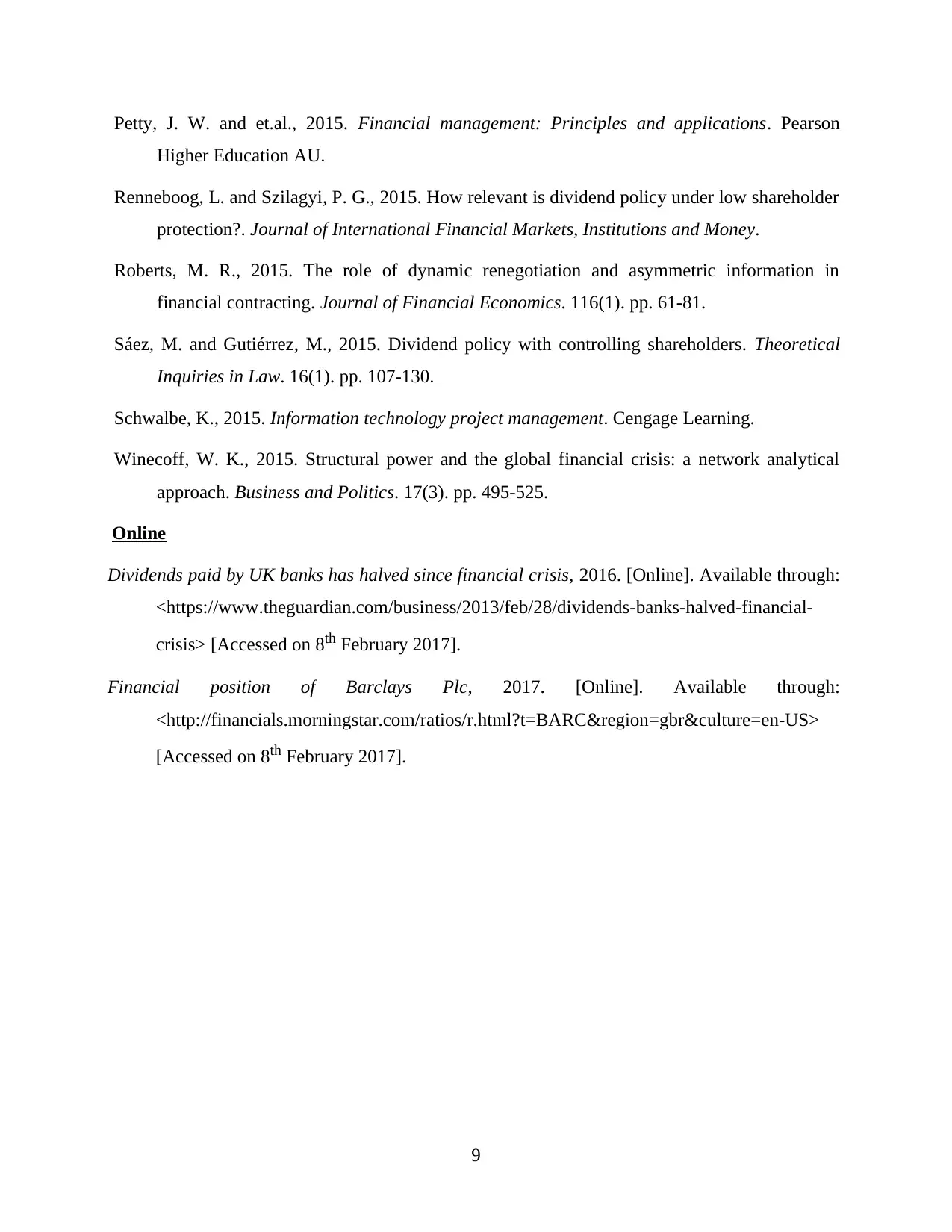
Petty, J. W. and et.al., 2015. Financial management: Principles and applications. Pearson
Higher Education AU.
Renneboog, L. and Szilagyi, P. G., 2015. How relevant is dividend policy under low shareholder
protection?. Journal of International Financial Markets, Institutions and Money.
Roberts, M. R., 2015. The role of dynamic renegotiation and asymmetric information in
financial contracting. Journal of Financial Economics. 116(1). pp. 61-81.
Sáez, M. and Gutiérrez, M., 2015. Dividend policy with controlling shareholders. Theoretical
Inquiries in Law. 16(1). pp. 107-130.
Schwalbe, K., 2015. Information technology project management. Cengage Learning.
Winecoff, W. K., 2015. Structural power and the global financial crisis: a network analytical
approach. Business and Politics. 17(3). pp. 495-525.
Online
Dividends paid by UK banks has halved since financial crisis, 2016. [Online]. Available through:
<https://www.theguardian.com/business/2013/feb/28/dividends-banks-halved-financial-
crisis> [Accessed on 8th February 2017].
Financial position of Barclays Plc, 2017. [Online]. Available through:
<http://financials.morningstar.com/ratios/r.html?t=BARC®ion=gbr&culture=en-US>
[Accessed on 8th February 2017].
9
Higher Education AU.
Renneboog, L. and Szilagyi, P. G., 2015. How relevant is dividend policy under low shareholder
protection?. Journal of International Financial Markets, Institutions and Money.
Roberts, M. R., 2015. The role of dynamic renegotiation and asymmetric information in
financial contracting. Journal of Financial Economics. 116(1). pp. 61-81.
Sáez, M. and Gutiérrez, M., 2015. Dividend policy with controlling shareholders. Theoretical
Inquiries in Law. 16(1). pp. 107-130.
Schwalbe, K., 2015. Information technology project management. Cengage Learning.
Winecoff, W. K., 2015. Structural power and the global financial crisis: a network analytical
approach. Business and Politics. 17(3). pp. 495-525.
Online
Dividends paid by UK banks has halved since financial crisis, 2016. [Online]. Available through:
<https://www.theguardian.com/business/2013/feb/28/dividends-banks-halved-financial-
crisis> [Accessed on 8th February 2017].
Financial position of Barclays Plc, 2017. [Online]. Available through:
<http://financials.morningstar.com/ratios/r.html?t=BARC®ion=gbr&culture=en-US>
[Accessed on 8th February 2017].
9
1 out of 11
Related Documents
Your All-in-One AI-Powered Toolkit for Academic Success.
+13062052269
info@desklib.com
Available 24*7 on WhatsApp / Email
![[object Object]](/_next/static/media/star-bottom.7253800d.svg)
Unlock your academic potential
Copyright © 2020–2025 A2Z Services. All Rights Reserved. Developed and managed by ZUCOL.





